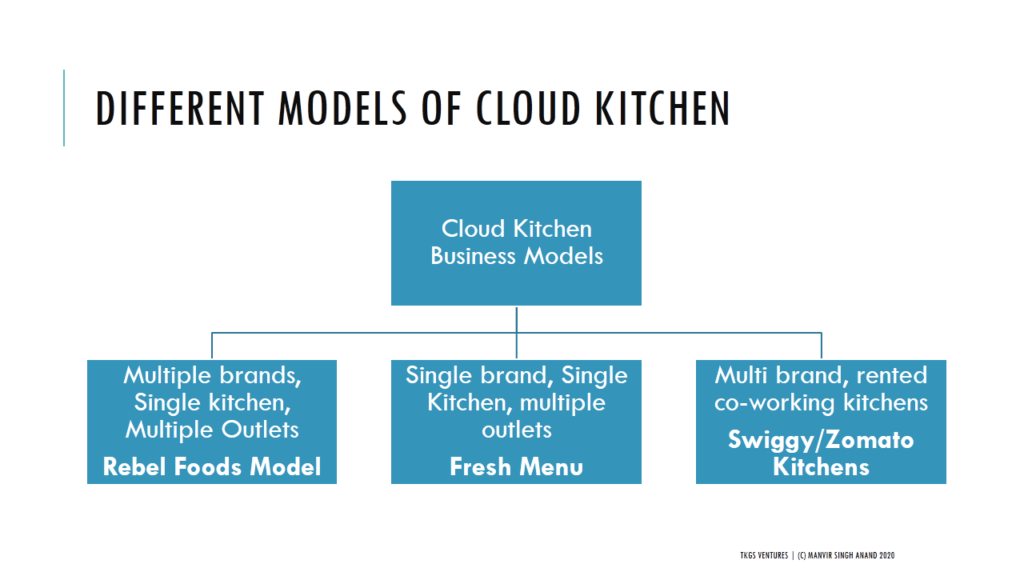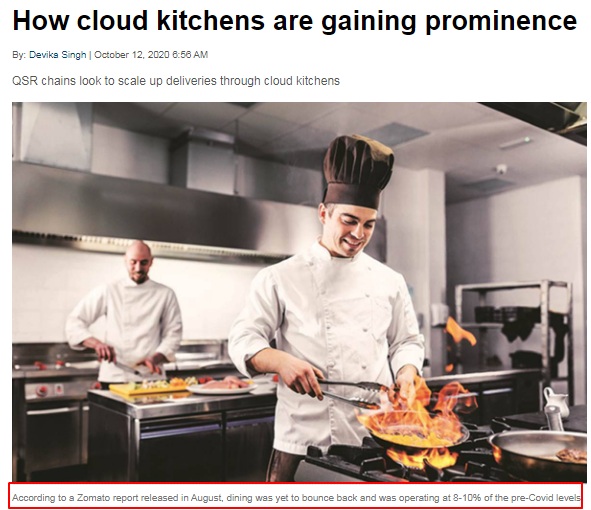According to a recent data, the Cloud Kitchen Industry is pegged to grow to $1 Bn Dollar Market size by 2021 i.e. ~ INR 7,500 Crore. Further, over 60% of the restaurant owners would want to pivot to a cloud kitchen as their next expansion move.
Trends have been noted that over half the consumption patterns are shifting towards take-away or delivery food which has become an essential practice in their lives.
While HoReCa segment realizes this shift, its quintessential for people to know the business models which are prevelant in the Cloud Kitchen Niche. While the Cloud Kitchen Concept is revolutionary in its own right, however, its the agility and flexibility in its business model which is extremely important.

My focus would be on the key 3 Business Models (for our ease of understanding) –
- Single brand, Single kitchen Model
This is the most basic yet vanilla cloud kitchen model. A restaurant with no dine-in facility, no physical outlet and orders come online. This is the model how most of the Cloud Kitchens take shape experimenting with single brand and trying to crack the Unit Economics game.
Example – Can be Fresh Menu – Which runs a Single Brand from a Single Kitchen and scales that across multiple outlets. In fact, Faasos (Erstwhile first brand of Rebels) first pivoted from a QSR model to a Vanilla Cloud Kitchen itself.
2. Multi-brand, Single Kitchen Model
As the model developed further, Cloud kitchens understood “Data is the new oil” and used the intelligence such as area wise demographics and statistics of customers like preferences, frequency, upsell triggers etc.
The concept here is to address the demand for the most ordered cuisine in a vicinity and focus on micro-niche cuisine with a focused marketing recall around a signature dish. This model makes the operational model effective as the costs, resources get divide between multiple brands and also, it opens better Unit Economics potential from the same outlet.
For eg – You have Faasos at an outlet with a daily sale of INR 10K, you add a Behrouz, Ovenstory – each brand will have its own revenue potential, accelerating the revenue for the cloud kitchen, keeping fixed costs constant.
- Access Kitchens Business model – Co-working for Kitchens
This Cloud Kitchen Model has received massive growth in recent times where Aggregators & Independent Real Estate Players (Access Kitchen Operators) rent a large bare shell area and convert that into smaller kitchens which are then sub-leased to cloud kitchens. The Capital Expenditure, Resources and relevant tie-ups are done by the access kitchen operators and just the cooking is done by the brands.
It works on a rental + commission of the sales model to cover the cost of the CAPEX invested by the AKO. It is a fantastic source for Cloud Kitchens who have a solid understanding of their Unit Economics and want to scale up quickly without investing upfront in Assets and location construction.
Other models also exist in the ecosystem like –
- Hybrid Cloud Kitchen Models – Single/Multi brand, Single or access Kitchens, with a storefront – which gives the opportunity to the cloud kitchen to sell online as well as consider Takeaway orders for their kitchen.
- Fully Outsourced Cloud Kitchen business model – where Cooking and delivery fully outsourced – A comparatively recent concept in the cloud kitchen business model landscape. In this model, you can outsource every single aspect of your cloud kitchen i.e. call center operations, kitchen preparation to delivery. A few startups in Hyderabad and Bangalore are experimenting with this model.
Both the models are For your information, however, if you really want to leverage and build a credible organization, knowledge of 3 business models will come extremely handy and can be applied in a phase manner by starting with a Single brand to slowly starting new brands to finally, scaling up through Access Kitchens.
So, if you have got a distinctive idea and you want a viable way to enter the market, cloud kitchens has a model to suit you the in the best possible way out. As they require minimum capital investment as compared to a full-fledged restaurant but give you a full chance to reach out to a large customer base.
This and more such details covered in my book — Cloud Kitchen Secrets.
Let me know your thoughts in the comments below.
Let’s connect –
